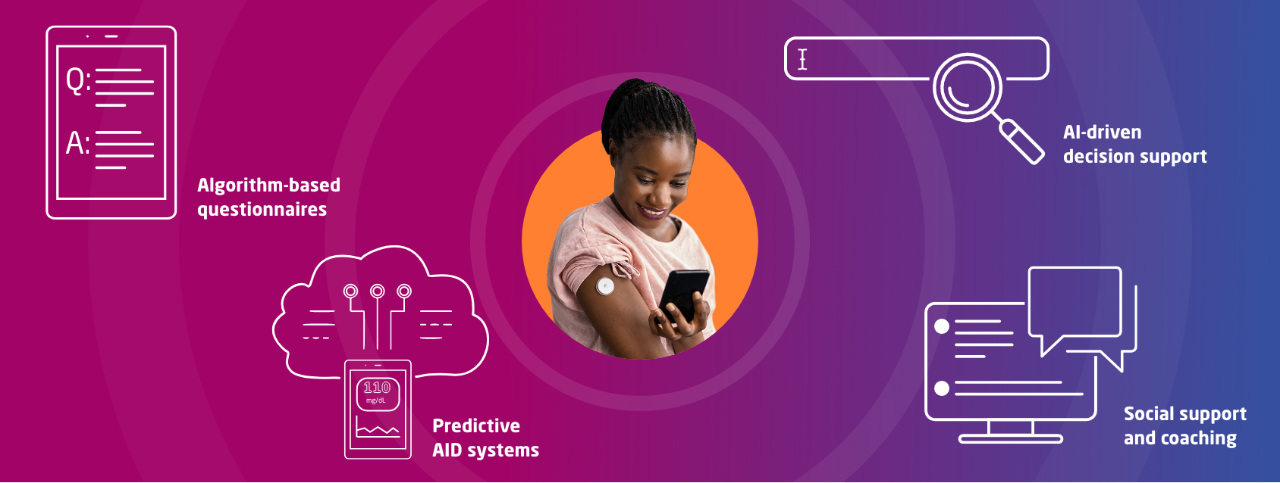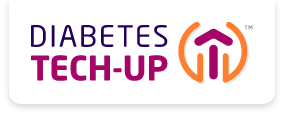The future of diabetes tech is being built right now: The 4 tools I’m most excited about
By Amy Tenderich, MA
6 min read

Some of the technologies described in this article are not yet in market. These technologies may continue to develop and further public information may become available as they emerge. Descriptions of these technologies and their features reflect the research and opinion of the author.
It’s an incredibly exciting time in the diabetes technology world. People often ask me about well-known tech advancements in the space like automated insulin delivery, and I’m happy to share my knowledge of how it’s coming along.
But I’m also extremely pleased that emerging diabetes tech is affecting more than how we take insulin. Tech developers are also working on innovative approaches to diabetes-related communication, self-management, nutrition education, and social support. Here are 4 types of current and emerging technology that intrigue me.
1. Algorithm-based questionnaires: Helping facilitate patient-provider communication
I’ll start with a communication tool that may help providers learn more about their patients and individualize their care.
A UK psychology professional and team have developed an adaptive, algorithm-based questionnaire that diabetes care providers can send to each patient prior to a visit. The survey, which takes the patient 3-5 minutes to complete on their mobile device or computer, helps proactively identify their challenges and priorities. Based on the patient’s responses in the early part of the questionnaire, the subsequent questions change to focus on information about their individual diabetes-related concerns or goals.1
The provider can then review the patient’s responses and start their conversation from a place of greater understanding, helping make the most of their appointment time.1 This sounds simple, but it is a step forward that I think can help health care professionals and people with diabetes have more positive interactions.
In my view, this kind of tech is in keeping with a trend toward greater empathy in diabetes care. Many health care organizations and medical educational institutions are starting to prioritize empathetic communication and bringing it into the culture with specialized training.2 Much more can still be done, but it’s exciting to see how tech is helping to move things in the right direction.
2. Artificial intelligence (AI): Striving to help patients build decision-making autonomy
AI can’t (and shouldn’t) replace the personalized care and experience of a licensed health care provider. However, AI is enabling people with diabetes to fill specific gaps in their knowledge as a complement to their provider’s care.
One app-based AI chat program in development, when it’s eventually launched, will allow patients to input queries about circumstances specific to them. For example, if a person on their lunch hour wants to know how the egg salad sandwich they’re considering may affect their glucose, they can ask the app. Then the AI generates an answer using the patient’s personal data, including from continuous glucose monitors (CGMs), insulin pumps, and health apps. The person gets an immediate, data-supported answer, which lets them decide whether the sandwich is a good choice, and how much insulin they may need to dose.
Other systems in development go one step further and use AI to recommend insulin dose adjustments based on patient glucose and insulin dosing data. One study of these decision support systems compared the algorithm’s dose recommendations to those of a physician, and the study found no significant differences between the two.3
*2022 study included 17 data cases of patients with type 1 diabetes taking multiple daily injections of insulin. The study compared insulin dose adjustment recommendations from 20 physicians with at least 3 years’ experience in treating patients with type 1 diabetes with recommendations of the automated decision support system (DSS) based on 3 weeks of glucose levels and insulin delivery data. The primary endpoint was the level of agreement and disagreement among the physicians compared to the level of agreement and disagreement between physicians and the DSS in regard to the recommended adjustment in treatment plan. Participating physicians and the DSS received the same information: patient characteristics, treatment plan, CGM-captured glucose data, app-captured insulin dosing data, and patient-reported carbohydrate consumption data.
As a person with diabetes, I’d appreciate it if my provider prescribed this type of tech. I’d see it as an extension of our partnership in diabetes self-management, as well as a sign of their trust in my ability to make decisions independently.

AI is enabling people with diabetes to fill specific gaps
in their knowledge as a complement to their provider’s care.
3. “Set it and forget it” AID systems: The quest for user-unassisted autonomous insulin delivery
Automated insulin delivery (AID) used to be referred to as the “artificial pancreas.” This was never an accurate description, even though an AID system and a pancreas do similarly regulate glucose levels and release insulin. The main difference is that AID systems to this point have still required periodic human input, such as announcing carbohydrates in meals, to help them release the right amount of insulin.4
While some people who use AID systems are comfortable making frequent adjustments, there’s an emerging option for people who prefer a more hands-off experience. One AID system recently approved by the FDA is designed to adjust insulin doses with minimal input from the wearer.5
What sets it apart from other AID systems is its data-driven ability to provide insulin at mealtimes without the patient entering carbohydrate counts. It uses data from the patient’s dosing and meal history to calculate and release a dose that’s customized to the user’s insulin needs.5 It’s not a true “artificial pancreas” that removes all burden from the user, but it is a meaningful and exciting step in that direction for AID technology.

Most AID systems require a person to announce the carb count of each meal, but some emerging systems can adjust the insulin dose with minimal input from the wearer.
4. Social support tech: Promoting community and self-management through online platforms
While many diabetes tech advances are understandably focused on the challenges of managing glucose, I’m also excited about emerging tech that’s having an impact on social support and lifestyle change for people with diabetes.
Online communities help bring people with diabetes together to exchange information, learn from one another’s experiences, and connect for emotional support. Certain web-based communities are using algorithms to help moderate forums, reduce commercial content and bot traffic, and limit posting by those with hostile intent.6 I know I feel more comfortable reaching out to connect with others in these dedicated online communities when some automated protection is in place.
There are also online resources which use tech and data to help people with diabetes change how they eat. One text-message based platform helps food-insecure people find access to healthy meals. Rather than having to settle for whatever food is available, users enter their location and dietary restrictions (including diabetes) to get matched with a restaurant or grocery store nearby that can provide food which meets their needs.7
Another developer has created an app to help people with diabetes learn about nutrition and self-management through AI-based coaching. It offers tips and guidance that may help people form healthy eating habits and learn how their food choices affect their condition. The app can also pair with other diabetes devices and create food logs to serve as a data-and meal-tracking tool.

These 4 exciting developments may help people connect with others and manage their diabetes independently.
Whether it helps with glucose management, doctor-patient interaction, lifestyle changes, or social support, technology is finding its way into many areas of need for people with diabetes. Of course, no piece of technology can fully take the place of a good relationship with an understanding health care provider. It’s up to the health care team to get to know their patients, learn about their challenges, priorities, and goals, and gauge what kind of tech (if any) may be right for them.
As I see it, how providers and patients put these technological advances to use may help shape the future of diabetes care.
Tech-up Follow-ups
- Ask 1 or 2 patients with diabetes what types of technology they use to help with their self-management.
- Research the technologies that are currently in market and see how you may be able to partner with your patient in using this tech.
- At your next visit with these patients, bring up this technology and offer to help the patient optimize their use of it.

Amy Tenderich, MA
Santa Barbara, California
Amy is a journalist, nationally known patient advocate, and diabetes tech expert. She was the founder and editor of DiabetesMine.com and former Editorial Director of Diabetes & Patient Advocacy at Healthline Media. She organizes and hosts the biannual DiabetesMine Innovation Forums (Innovation Summit, D-Data ExChange) that connect patient and industry leaders. Amy also lives with diabetes, having been diagnosed with type 1 diabetes in 2003.
Amy Tenderich received a fee from Novo Nordisk for her participation.
–— Recommended for you –—
References
- Barnard-Kelly K, Kelly RC, Chernavvsky D, Lal R, Cohen L, Ali A. Feasibility of Spotlight Consultations Tool in Routine Care: Real-World Evidence. J Diabetes Sci Technol. 2022;16(4):939-944. doi:10.1177/1932296821994088
- James T. Building Empathy into the Structure of Health Care. Harvard Medical School. January 12, 2023. Accessed July 2023. postgraduateeducation.hms.harvard.edu/trends-medicine/building-empathy-structure-health-care
- Nimri R, Tirosh A, Muller I, et al. Comparison of Insulin Dose Adjustments Made by Artificial Intelligence-Based Decision Support Systems and by Physicians in People with Type 1 Diabetes Using Multiple Daily Injections Therapy. Diabetes Technol Ther. 2022; 24(8)564-572. doi:10.1089/dia.2021.0566
- Sherr J, Heinemann L, Fleming G, et al. Automated Insulin Delivery: Benefits, Challenges, and Recommendations. A Consensus Report of the Joint Diabetes Technology Working Group of the European Association for the Study of Diabetes and the American Diabetes Association. Diabetes Care. 2022;45:3058-3074. doi:10.2337/dci22-0018
- FDA Clears New Insulin Pump and Algorithm-Based Software to Support Enhanced Automatic Insulin Delivery. News release. US Food and Drug Administration. May 19, 2023. Accessed July 2023. www.fda.gov/news-events/press-announcements/fda-clears-new-insulin-pump-and-algorithm-based-software-support-enhanced-automatic-insulin-delivery
- Milne DN, McCabe KL, Calvo RA. Improving Moderator Responsiveness in Online Peer Support Through Automated Triage. J Med Internet Res. 2019;21(4):e11410. doi:10.2196/11410
- Visram T. This food-insecurity solution wants to solve more than hunger. Fast Company. December 22, 2021. www.fastcompany.com/90706558/this-food-insecurity-solution-wants-to-solve-more-than-hunger
The Diabetes Tech-upTM Podcast
Join our expert cohosts for a series of discussions about how they’re integrating diabetes tech with patient-centered care to help optimize diabetes management.
The Mission of Diabetes Tech-upTM
Diabetes Tech-upTM is sponsored by Novo Nordisk, a global leader in diabetes. We believe that adoption of innovative technologies can help appropriate patients better manage diabetes. Our goal is to provide information to help health care professionals on the front line of diabetes care strengthen their understanding of diabetes technologies and implement them where they can have the greatest impact.




Share: